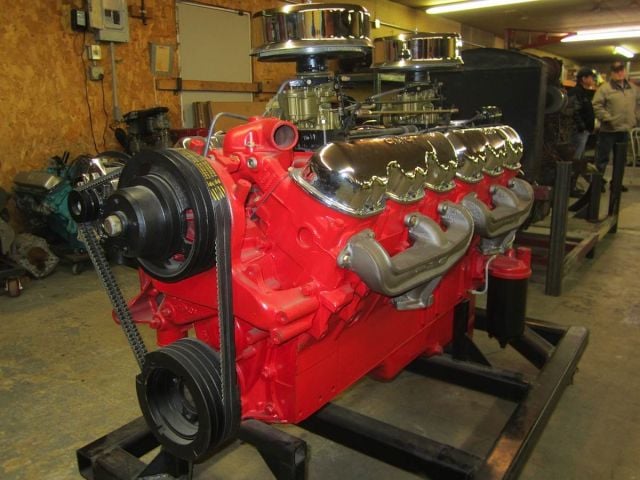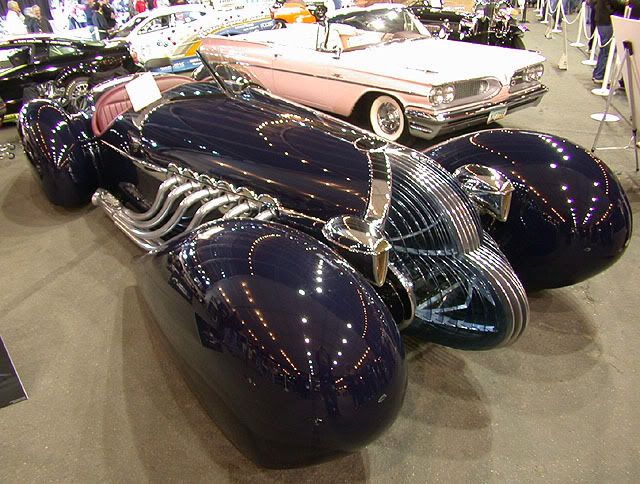A Look Back at the 702ci GMC Twin-Six V12 Engine
By Mike Magda, posted on Feb 11, 2013 in News
(7) Comments
 Here’s a mythbuster: The GMC Twin-Six V12 is not two V6 engines welded together, although at first glance that’s the immediate reaction.
Here’s a mythbuster: The GMC Twin-Six V12 is not two V6 engines welded together, although at first glance that’s the immediate reaction.
“The block is one-piece with oversized bore spacing for improved cooling, and it’s equipped with seven main bearings,” says Ron Quarnstrom, who is forming a strategy to dyno test this engine at his R&R Performance shop in Minnesota. “It also has a one-piece, hardened forged-steel crankshaft that weighs 180 pounds.”
The Twin-Six is built around a 1-piece block and crank while carrying over nearly 60 major parts from the GMC V6 engines.
 Quarnstrom has quite the challenge ahead of him as the engine weighs about 1,500 pounds fully dressed. That’s well beyond the capacity of the shop’s cherry picker and the chain hoist in the dyno cell. Quarnstrom — who’s been asked to dyno a Chrysler 30-cylinder tank engine but can’t find a way to get it through the garage door — says he can use a heavy-duty cart to roll the 4.4-foot-long engine into the cell.
Quarnstrom has quite the challenge ahead of him as the engine weighs about 1,500 pounds fully dressed. That’s well beyond the capacity of the shop’s cherry picker and the chain hoist in the dyno cell. Quarnstrom — who’s been asked to dyno a Chrysler 30-cylinder tank engine but can’t find a way to get it through the garage door — says he can use a heavy-duty cart to roll the 4.4-foot-long engine into the cell.
“When I ordered my SF-902 dyno, I asked Superflow to add a second capacity valve to stuff the absorber with more water,” says Quarnstrom. “Conventional water-brake dynos tend to be able to handle higher rpm horsepower rather than down low torque.”
Quarnstrom wants to pull the engine down low to see where the torque curve truly begins. He also has plans to couple the engine to a TH400 transmission as Bob Bendtsen of Speed Gems — who is also owner of the Twin-Six — is helping the shop build fixtures for an engine-tranny test program. The goal is to have the capability to adapt any type of engine, as R&R is well-known for attracting unusual powerplants.
“In the past, you could only dyno one of these oldies if you had a way of coupling up to it,” explains Quarnstrom. “With Speed Gems building the transmission adapters for almost anything, this changes the landscape.”
The Twin-Six has a 4.560 x 3.580 bore/stroke for 702ci. It was produced in the early to mid ‘60s for GMC commercial trucks and was often used in industrial applications like irrigation. The design is based off the GMC 60-degree V6 engine, and almost 60 major parts are interchangeable. The oil pan is one part that doesn’t swap over as it holds four gallons of lubricant.
Some other interesting facts; the wrist pins are a whopping 1.24-inch diameter, and there were four piston rings: three compression and one oil. There were two distributor caps running off a single distributor drive. There are 56 head bolts!
 “The hydraulic lifters ran in an oil bath, the cooling system utilized three thermostats and the water pump delivered an unheard of 118 gpm with less than a four-degree temperature change across the entire engine,” says Quarnstrom.
“The hydraulic lifters ran in an oil bath, the cooling system utilized three thermostats and the water pump delivered an unheard of 118 gpm with less than a four-degree temperature change across the entire engine,” says Quarnstrom.
SAE ratings of the day put this engine at 250 to 275 horsepower( 2,400 rpm) with 585 to 630 lb-ft peak torque at 1,600 rpm.
“This GMC engine has an unique distinction; it makes the most power between 2,000 to 3,000 rpm of any automotive-based naturally aspirated 87 octane fuel engine,” claims Quarnstrom, adding that only 5,000 of these engines were produced.
The Twin-Six engine has been used in a few street rods, most notably the Blastolene B702 and Pat McNeal’s 1942 cab-over.
By Mike Magda, posted on Feb 11, 2013 in News
(7) Comments
 Here’s a mythbuster: The GMC Twin-Six V12 is not two V6 engines welded together, although at first glance that’s the immediate reaction.
Here’s a mythbuster: The GMC Twin-Six V12 is not two V6 engines welded together, although at first glance that’s the immediate reaction.“The block is one-piece with oversized bore spacing for improved cooling, and it’s equipped with seven main bearings,” says Ron Quarnstrom, who is forming a strategy to dyno test this engine at his R&R Performance shop in Minnesota. “It also has a one-piece, hardened forged-steel crankshaft that weighs 180 pounds.”
The Twin-Six is built around a 1-piece block and crank while carrying over nearly 60 major parts from the GMC V6 engines.
 Quarnstrom has quite the challenge ahead of him as the engine weighs about 1,500 pounds fully dressed. That’s well beyond the capacity of the shop’s cherry picker and the chain hoist in the dyno cell. Quarnstrom — who’s been asked to dyno a Chrysler 30-cylinder tank engine but can’t find a way to get it through the garage door — says he can use a heavy-duty cart to roll the 4.4-foot-long engine into the cell.
Quarnstrom has quite the challenge ahead of him as the engine weighs about 1,500 pounds fully dressed. That’s well beyond the capacity of the shop’s cherry picker and the chain hoist in the dyno cell. Quarnstrom — who’s been asked to dyno a Chrysler 30-cylinder tank engine but can’t find a way to get it through the garage door — says he can use a heavy-duty cart to roll the 4.4-foot-long engine into the cell.“When I ordered my SF-902 dyno, I asked Superflow to add a second capacity valve to stuff the absorber with more water,” says Quarnstrom. “Conventional water-brake dynos tend to be able to handle higher rpm horsepower rather than down low torque.”
Quarnstrom wants to pull the engine down low to see where the torque curve truly begins. He also has plans to couple the engine to a TH400 transmission as Bob Bendtsen of Speed Gems — who is also owner of the Twin-Six — is helping the shop build fixtures for an engine-tranny test program. The goal is to have the capability to adapt any type of engine, as R&R is well-known for attracting unusual powerplants.
“In the past, you could only dyno one of these oldies if you had a way of coupling up to it,” explains Quarnstrom. “With Speed Gems building the transmission adapters for almost anything, this changes the landscape.”
The Twin-Six has a 4.560 x 3.580 bore/stroke for 702ci. It was produced in the early to mid ‘60s for GMC commercial trucks and was often used in industrial applications like irrigation. The design is based off the GMC 60-degree V6 engine, and almost 60 major parts are interchangeable. The oil pan is one part that doesn’t swap over as it holds four gallons of lubricant.
Some other interesting facts; the wrist pins are a whopping 1.24-inch diameter, and there were four piston rings: three compression and one oil. There were two distributor caps running off a single distributor drive. There are 56 head bolts!
 “The hydraulic lifters ran in an oil bath, the cooling system utilized three thermostats and the water pump delivered an unheard of 118 gpm with less than a four-degree temperature change across the entire engine,” says Quarnstrom.
“The hydraulic lifters ran in an oil bath, the cooling system utilized three thermostats and the water pump delivered an unheard of 118 gpm with less than a four-degree temperature change across the entire engine,” says Quarnstrom.SAE ratings of the day put this engine at 250 to 275 horsepower( 2,400 rpm) with 585 to 630 lb-ft peak torque at 1,600 rpm.
“This GMC engine has an unique distinction; it makes the most power between 2,000 to 3,000 rpm of any automotive-based naturally aspirated 87 octane fuel engine,” claims Quarnstrom, adding that only 5,000 of these engines were produced.
The Twin-Six engine has been used in a few street rods, most notably the Blastolene B702 and Pat McNeal’s 1942 cab-over.








Comment